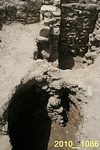| Collection: | Corinth | |
| Type: | Basket | |
| Name: | Nezi Field, context 6881 | |
| Area: | Nezi Field | |
| Context Type: | Built Pithos | |
| Title: | Built pithos | |
| Category: | Cut | |
| Notebook: | 1104 | |
| Context: | 6881 | |
| Page: | 0 | |
| Date: | 2010/05/10 | |
| Stratum: | 10 - 15% pottery, tile, stones - medium - coarse pebbles, small boulders (angular and tabular) | |
| Description: | Top slope of the context is level. The soil color is dark greyish brown. The soil compaction is soft. It is clayey silt. Structure materials: boulders (subrounded and spherical), tile. Material size: tile (broken, 2-4cm high). Material finish: unworked. Material construction: mixed, see notes. Material bonding: mud-plaster. | |
| Notes: | 6881 is a tile and rubble built pithos built into the room northwest of the courtyard of the Byzantine house. It was previously excavated as 5876, 6493, and 6638. 5876 may belong to a later phase of the pithos, as noted by the use of cement as bonding. 6493 and 6638 are very similar to 6881 in materials and bonding. The previous structures have been called a well, but we are calling it a built pithos (as in interpretation/formation of 5876). After excavating the fill in the pithos (6877 and 6879), Sanders advised recording the pithos and then dismantling it. Excavation proceeded. Plaster was noted as 0.02m thick on the tile; several boulders were removed from the structure and one of these was built into the interior face of the pithos (had plaster on it). This particular boulder was along the E-W line of wall 10111; Wells suggested that in addition to cutting this wall, 6881 might also be using the wall. On the north and south sides of the interior, square cuttings were made (approx. 10 cm), presumably to allow access to bottom of pithos during construction, or later, during use. The tiles are corbelled, with boulders also randomly used in the courses. A fragment of a terracotta moulding with an egg and dart pattern was found built into the pithos, as well as a roughly cylindrical stone with a dowel hole at the top (will wait for cleaning to determine exact features/function). Excavation of the pithos was completed when the cement floor of the pithos was excavated. With the excavation complete it was apparent that the pithos made extensive use of a wall running E-W; this may be wall 10111 and/or wall 6526. Most blocks have visibly been repositioned to contour to the curve of the pithos, but some blocks may be in their original positions. These blocks were not excavated; there is some concern that they may present a danger of contamination if further excavation of the area under the pithos is carried out. Rubble was also visible on the N and S sides of the area excavated, also used in the corbelling, and this may represent yet another wall. There is a layer of tile and fill below the pithos floor, which we will now excavate. Later notes (CMT/DPG 19-5-10): Having removed the upper portion of wall 10111 that abutted the built pithos on the W, it was decided to remove the blocks reused from 10111 in the built pithos to create the curved sides on the E and W. Stones, avg. 0.30x0.20x0.25. 3 pieces of unworked marble were found built into the pithos: (1) 0.14x0.08x0.05, (2) 0.17x0.14x0.04, (3) 0.16x0.13x0.09. | |
| Context Pottery: | Fineware. bowl. 1 rim. 2 bodysherds. ; Coarseware. amphora. 5 bodysherds. ; Coarseware. 1 handle. 2 bodysherds. ; Fineware. 9 bodysherds. ; Fineware. plate. 1 bodysherd. ; Fineware. 10 bodysherds. ; Coarseware. plate. | |
| Pottery Summary: | 23 frag(s) 0.23 kg. (0% saved) fineware. | |
| 225 frag(s) 6.04 kg. (0% saved) coarseware. | ||
| 86 frag(s) 0.89 kg. (0% saved) cooking ware. | ||
| Context Artifacts: | Terracotta sima with egg and dart moulding, probably from South Stoa (cf. Corinth I.IV Pl. 39.2), 1 (saved to lot); Glass clear light blue bowl with folded over rim rim 1; glass clear blue rim 1, clear light blue bs 1; Bone- metacarpal of Capra aegagrus hircus (Sheep/Goat) - 1 example(s).; Bone- metapodial of Sus scrofa (Wild Boar or Domestic Pig) - 2 example(s).; Bone- vertebrae of Mammalia, md (Mammal - Medium) - 1 example(s). | |
| Period: | Byzantine | |
| Chronology: | 10th-11th century NPD | |
| Grid: | 264.42-263.47E, 1036.66-1037.57N | |
| XMin: | 263.47 | |
| XMax: | 264.42 | |
| YMin: | 1036.66 | |
| YMax: | 1037.57 | |
| Site: | Corinth | |
| City: | Ancient Corinth | |
| Country: | Greece | |
| Masl: | 82.71-84.39m. | |
| References: | Report: Nezi Field 2010 by Dominic Galante, Christina Trego (2010-05-03 to 2010-05-21) Images (7) |
|


